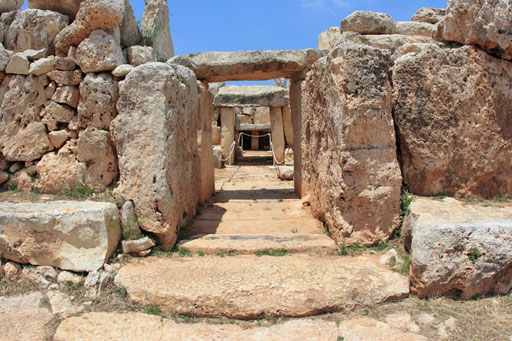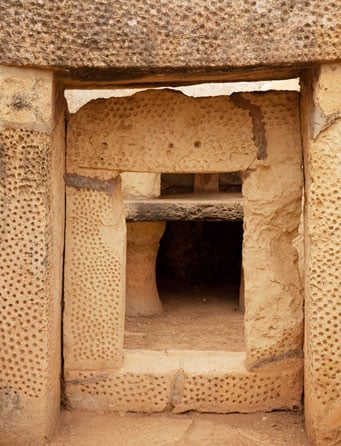
Hagar Qim, the Neolithic Temple Complex of Malta
Hagar Qim is a megalithic temple complex on the island of Malta. This temple complex is said to belong to the Neolithic era, i.e. 3600 – 3200 BC. Although Hagar Qim is one of the main Neolithic temple complexes in Malta, it should be pointed out that it was not the only one in the region. For instance, other temples include Tarxien and Skorba on Malta, and Ggantija and Xewkija on the nearby island of Gozo. Although Hagar Qim was first excavated in 1839, the temple complex itself had never really been completely buried. This is due to the fact that the tallest stones of the temple remained exposed above the ground over the millennia, and are even said to have been featured in 18 th and 19 th century paintings.
The Hagar Qim (‘Worshipping Stones’) temple complex consists of a central building and the remains of at least two other structures. It has been pointed out that unlike most other Neolithic Maltese temple complexes, the Hagar Qim temple complex consists of only one, instead of the more common two or three temples. Nevertheless, its design is similar to these other Neolithic temples. This design consists of a large forecourt and a monumental façade. The Hagar Qim temple complex is made up of a series of C-shaped rooms known as apses. These apses are arranged on each side of a central paved space. Walls and slabs with square portholes cut through as doorways were used to screen off the apses. It has been noted this practice is unusual, as the apses of other similar temples have not been so well screened off.

Walls with square portholes cut out of them. Source: BigStockPhoto
One of the apses in seems to have an astronomical function. This apse can be accessed through the inner passage, and has an inner enclosure formed by a setting of low stone slabs. At the rear of this apse is a small elliptical hole. It has been observed that during the Summer Solstice, the rays of the rising sun pass through this hole and illuminate one of the low slabs. If this interpretation were correct, it could suggest that the Hagar Qim temple complex was used for fertility rituals. This may be supported by the discovery of stone and clay statuettes of obese figures, or fat ladies, who may have been fertility symbols.

Hagar Qim. Source: BigStockPhoto
Another fascinating aspect about the Hagar Qim temple complex can be seen from the perspective of an archaeological conservator. The materials used by the Neolithic builders to construct the Maltese temple complexes can be found locally. In addition to the hard, chalky coralline limestone, the softer globigerina limestone was also used. Although the temple has been well preserved for several millennia, exposure to the elements is now taking its toll. For instance, on the southern wall of the temple, which is made of the globigerina limestone, considerable surface flaking can be detected. By comparison, another temple complex, Mnajdra, just 500 m away from Hagar Qim, and equally exposed to the elements, shows much less damage. This is due to the harder coralline limestone that was used in its construction.

Nearby site of Mnajdra. Source: BigStockPhoto
In order to mitigate the damage done to the Hagar Qim temple complex by the elements, a roof was added over the site only a few years ago. Although this modern structure is useful in reducing the erosion caused by the exposure of the temple to the elements, it would no doubt have an effect on the aesthetic value of the site and the landscape as a whole. Perhaps this is one of the dilemmas of the conservators – whether to preserve the site by adding a structure that would affect its aesthetic value, or to leave the site in its natural condition and risk losing it eventually. I suppose it is clear which option one would go for, and perhaps this is the best that can be done for the time being.
Featured image: The Hagar Qim Temple Complex. Photo source: BigStockPhoto
By Ḏḥwty
References
enkidu41, 2009. Hagar Qim - Ancient Temple in Malta in Mainland. [Online]
Available at: http://www.megalithic.co.uk/article.php?sid=10455
Heritage Malta, 2014. Ħaġar Qim Temples. [Online]
Available at: http://heritagemalta.org/museums-sites/hagar-qim-temples/
Hirst, K. K., 2014. The Ancient Temples of Malta. [Online]
Available at: http://archaeology.about.com/od/neolithic/ss/malta_temples.htm
Sacred Destinations, 2014. Hagar Qim Temple, Qrendi. [Online]
Available at: http://www.sacred-destinations.com/malta/hagar-qim-temple
UNESCO, 2014. Megalithic Temples of Malta. [Online]
Available at: http://whc.unesco.org/en/list/132
Wikipedia, 2014. Ħaġar Qim. [Online]
Available at: http://en.wikipedia.org/wiki/%C4%A6a%C4%A1ar_Qim
www.MalteseRing.com, 2014. Archaeology of Malta. Hagar Qim and Mnajdra Temples. [Online]
Available at: http://www.maltesering.com/archaeology_hagar_qim_mnajdra.asp
















Comments
A very informative tour of the temple site. Despite the presence of the canopy overhead, it is one of the better temple sites in Malta. Actually maybe that's because of the protection it gets from the elements, situated as it is in an exposed coastal location. Should definitely be on the agenda for anyone interested in the history of the island.